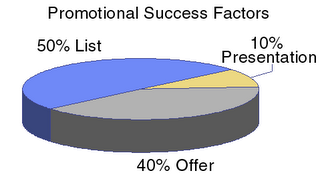The Rule of List, Offer & Presentation
Think about it... if the rule holds true, what this suggests is that all the money spent on impressive graphics and clever copywriting contributes only 10% to the success of an advertisement or promotion. Scary.

So let's look at where the 90% comes from. The rule suggests that 50% is attributed to the "List". For a mailing, it's the mailing list, for a print ad, it's the circulation list, for an event, it's the attendees list, and so on. The promotional quality of the list is what's important. In the case of lists, quality is determined by the relevance of the members of the list to the promotion being made. Are they in the target marketplace? Are they decision makers? Is there evidence that they respond to this type of promotion? How long ago? These are all questions important in selecting a list. For example, the notion of advertising in a magazine without understanding the circulation list or exhibiting in an event without understanding the attendees is essentially promoting "blind" and the results are likely to be underwhelming.
The list is a significant component of promotional success, but where many marketers go wrong is failing to make an "offer" to the list. They may create a beautiful and clever print ad, they may place it in a magazine with an appropriate circulation list, but they fail to offer the prospective viewer any reason to act. In effect, an ad without an offer is like me introducing myself to someone I've been dying to meet, and then saying only "Hi, my name is Kurt" and then walking away. What's the point?
An offer is an invitation to act -- a call to action. An offer can be as simple as "Buy GeeWhiz today!" or as complex as "Buy GeeWhiz at 20% off, while supplies last, one to a customer; offer expires September 30, 2006". Some offers work betters than others but any offer works better than none at all.
There is both science and art to making a compelling offer that will evoke a good response from a list of prospects. The science of good offers has been developed through years of empirical testing -- principally through "split-testing" of different offers (sending one offer to group A and another to group B and statistically comparing results). Testing in this way has proven that different offers have different strengths. For example, a sample list of offers is shown below, in order, from strongest to weakest:
- "Sweepstakes" or contests (e.g. "Win $2,500 cash and a trip to Costa Rica...")
- FREE!
- 25% Off!
- No Risk, Money Back Guarantee.
- Limited time or quantity (e.g. "Offer good only until
..." or "Only 100 available!" - Send for information.
- Have a salesperson call.
The art of good offers is how we package the science. For example, "50% off", "Save $100 each", and "Buy one, get one FREE!" are financially equivalent for a product with a $200 SRP --but each evokes different buying dynamics. Likewise, "Call 800-555-11111 for installation details" is essentially the same as "Call 800-555-1111 for your FREE planning guide".
With offers, it's also a good idea to keep in mind the effect of a strong offer on your entire sales cycle. A strong offer may result in an excellent response rate to your promotion. But the leads that are generated by it may be more difficult to close or have a low closing percentage. For example, a compelling offer in an advertisement for network management tools might be "Ask for our FREE planning guide and we'll send you a check for $25!" Almost certainly you'll be asked for many planning guides... but the close rate on prospects generated in this way will be low. Why? The responder wants the $25, not the guide or product. On the other hand, with an offer of a rebate of $25, the offer associates the incentive with the desired action -- i.e. you get the $25 when you buy. The response rate will be lower, but the quality of the lead will be higher.
Bottom Line
Make sure all your promotional work is vetted against the rule of List, Offer, and Presentation. Check each element to ensure that your promotion is focused on the right audience, includes a compelling (to the audience) offer, and is presented in a way that will make the offer stand out.
Click KLynn Business Consultants to link to the KLynn consulting site.
*This rule of thumb is actually industry legend in the direct marketing world. I only claim it as my own because so few people actually practice it.
